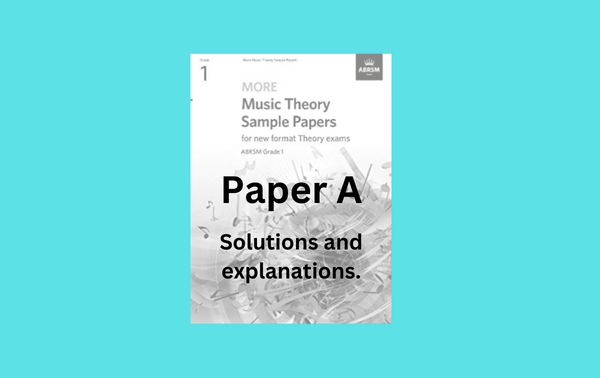Here, you’ll find the answers, and explanations to the questions in Music Theory Sample Papers, ABRSM Grade 1 Paper A.
Table of contents for Music Theory Sample Papers, ABRSM Grade 1 Paper A
Click on the question below to go directly to it explanation.
Section 1: Rhythm
Question 1.1
Question 1.2
Question 1.3
Question 1.4
Question 1.5
Question 1.6
Section 2: Pitch
Question 2.1
Question 2.2
Question 2.3
Section 3: Keys and Scales
Question 3.1
Question 3.2
Question 3.3
Question 3.4
Question 3.5
Question 3.6
Question 3.7
Question 3.8
Section 4: Intervals
Question 4.1
Question 4.2
Section 5: Tonic Triads
Question 5.1
Question 5.2
Question 5.3
Section 1: Rhythm ABRSM Grade 1 Music Theory Exam
Question 1.1: Time Signature
In this section, students are expected to determine the time signature for a given bar of music.
Question 1.1 (a)
The time signature is 3/4 time:

Question 1.1 (b)
The time signature is 4/4 time:

Question 1.1 (c)
The time signature is 2/4 time:

Question 1.2
In this section, students are expected to draw a bar line for a given piece of music.
Question 1.2(a)
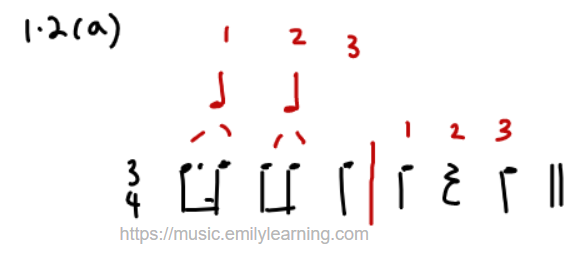
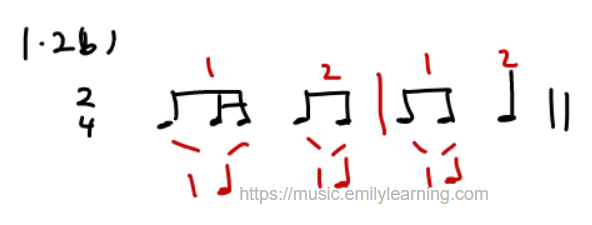

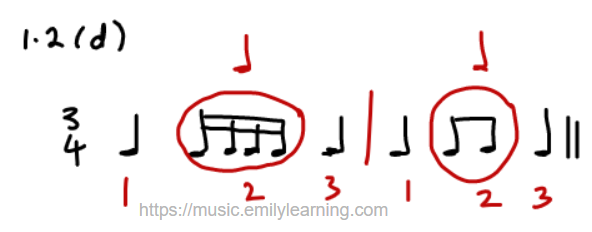
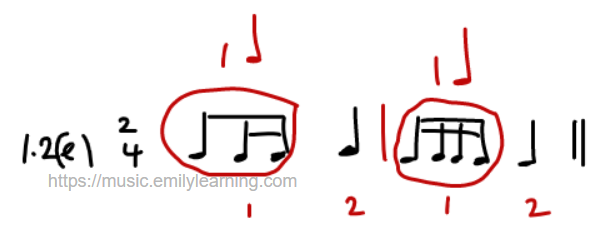
Question 1.3
a. How many minims are there in a semibreve?
Answer: 2
b. How many quavers are there in a minim?
Answer: 4
Question 1.4
How to correctly group 6 quavers in 3/4 time.
In 3/4 time, if all the notes are quaver, we can beam them all together.
Question 1.5
In the first box, we should have a semiquaver rest instead of a quaver rest.
Second box is correct.
Third box is incorrect. Although the piece is in 2/4 time, whenever the entire bar is at rest, we use a full bar rest.
Question 1.6
If a crotchet has a note value of 1, then
- a semibreve will have a note value of 4,
- a minim will have a note value of 2,
- a dotted quaver will have a note value of ¾
Arranging the notes from longest to shortest note value, we have:
Semibreve, minim, crotchet, dotted quaver
Section 2: Pitch ABRSM Grade 1 Music Theory Exam
Question 2.1
In this question, you are asked what the notes are. Apart from knowing the notes on the music stave, students are also required to indicate any accidentals ( either from key signature or explicitly written beside the note)
Answers:
a. F#
b. G
c. C
d. B flat
e. A
f. C#
g. E
Question 2.2
In this question, you are asked to determine which is the lower note of the 2. For such a question, note that for the same note, flat is the lowest, followed by natural, then sharp.
Here’s the answer for question 2.2.
a. G natural is lower ( than G#)
b. E flat is lower (than E natural)
c. B flat is lower ( than B natural)
d. F natural is lower ( than F#)
Question 2.3
In this question, you are required to determine the clef to get the note stated.
Here’s the answer for question 2.3
a. Treble clef
b. Treble clef
c. Treble clef
d. Bass clef
Section 3: Keys and Scales ABRSM Grade 1 Music Theory Exam
Question 3.1
Here’s the key signature of G Major in bass clef:

Question 3.2
Here’s the key signature of F Major in treble clef:

Question 3.3
Here, we are required to tick 3 boxes where accidentals are needed to form a melody in F Major.
As F Major has only B flat, we look for B in the melody. These are the notes that will require accidentals.
A tick should be placed here:
- Bar 2 first note
- Bar 3 first note
- Bar 4 second note
Question 3.4
Given C Major ascending scale, we are asked to find 2 pairs of notes that are a semitone apart.
The 2 pairs of notes that are a semitone apart are:
- E to F
- B to C
Question 3.5
Question 3.5 are true/ false questions on keys and scales.
Here’s the answer:
a. True
b. True
c. True
d. False
Question 3.6
In question 6, you are given 3 scales ( either asecending or descending), and you are required to determine which one is the correctly written one.
This question is on D Major ascending scale.
The given scale starts and ends with D – so option 2 is out.
D Major has F# and C#. Hence, the first option is a correctly written scale.
Question 3.7
In question 3.7, you are asked whether a given scale is correctly written.
In this question, you are asked whether the scale written is G Major descending. As G Major has F#, this given scale written has A# ( instead of F#), hence it is not a correctly written G Major descending scale.
Answer: false
Question 3.8
In this question you are asked to find 2 notes which are the incorrectly written in the scale.
For this question, you are given F Major descending scale. F Major has B flat. Looking at the given scale, the flat is on G and there is no flat on B. Hence, a cross should be placed at B (4th box from the left) and G flat (6th box from the left, or 2nd box from the right).
Section 4: Intervals ABRSM Grade 1 Music Theory Exam
Question 4.1
Question 4.1 Intervals
a. To form a 5th, C should be written
b. To form a 8th/8ve, F should be written
c. To form a 2nd, G should be written
d. To form a 3rd, A should be written
e. To form a 7th, E should be written
Question 4.2
In this question, students are asked to select the correct interval for each pair of notes.
Here’s the answer:
a. 8th/8ve
b. 4th
c. 2nd
d. 3rd
e. 6th
Section 5: Tonic Triads ABRSM Grade 1 Music Theory Exam
Question 5.1
Question 5.1 is a true/ false question. You will be given a chord and asked whether it is the tonic triad for a given key.
Here’s the answer:
a. True
b. False
c. False
Question 5.2
In question 5.2, you are required to add an additional note to complete the tonic triad.
Here’s the answer:
a. F#
b. G
c. G
Question 5.3
In question 5.3, a tonic triad is treble or base clef is written, and students need to determine that is a tonic triad of which key.
Here’s the answer for question 5.3:
a. F Major
b. C Major
c. G Major
Section 6: Terms and Signs ABRSM Grade 1 Music Theory Exam
This question is on terms and signs.
Here’s the answers:

slur, perform smoothly

60 crotchet beats in a minute
ritardando
gradually getting slower
dolce
sweet
p
quiet
Section 7: Music in Context ABRSM Grade 1 Music Theory Exam
7.1 True
Reason: Rall.,which means gradually getting slower is seen in bar 7.
7.2 Bar 3
Tonic triad of G Major is made up of G, B and D. Bar 3 is made up of the notes D, B, G, B, which contain the 3 notes, G, B and D needed to make the tonic triad of G Major
7.3
a. Answer: semiquaver
Reason: Among crotchet, semiquaver, quaver and minim, the one with the smallest note value is the semiquaver, followed by the quaver, crotchet then minim.
Semiquavers could be found in bar 7 of the music.
b. Bar 5
c. E
More on Grade 1 ABRSM Online Music Theory Exam
- About the exam
- ABRSM Grade 1 Online Practice Paper – Video explanation
- ABRSM Grade 1 Music Theory Sample Papers Worked Solutions:
- All posts on ABRSM Music Theory Grade 1
